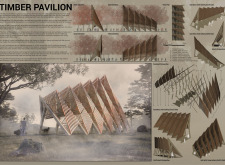5 key facts about this project
The Timber Pavilion serves as an exploration of the relationship between architecture and nature, focusing on sustainability and user interaction. It is designed to fit well in both urban and rural areas, allowing for flexible use in different environments. The building is fully demountable, reusable, and recyclable, demonstrating a commitment to reducing environmental impact while providing an engaging space for visitors.
Form and Structure
The pavilion features a series of interconnected A-frames that twist and bend, following the natural shape of the land. This design allows the structure to rise to a central peak, creating a dynamic and visually interesting form. The upward movement of the A-frames enhances the feeling of openness, encouraging a connection to the sky and the surroundings.
Façade and Light Interaction
The building's façade includes louvred panels made from hardwood timber strips. These strips resemble tree trunks and leafy canopies, further connecting the structure to its natural environment. The façade allows light to filter through, creating shifting patterns of shadow and brightness inside the pavilion. As the sun moves, the interior atmosphere changes, offering a variety of experiences throughout the day.
Sustainability Measures
Designed with a focus on ecology, the Timber Pavilion uses removable stakes for anchoring, ensuring no permanent footprint is left when it is taken down. The project also supports environmental sustainability by pledging to plant a new tree for every tree used in construction. This approach aligns with modern architectural practices that emphasize care for the environment and efficient use of resources.
User Engagement
Accessibility and interaction are key elements of the pavilion's design. The layout encourages people to engage with both the space itself and the surrounding nature. Visitors can find areas for quiet reflection or lively play, making it a versatile gathering spot. The incorporation of nearby trees into the experience enhances the connection to nature.
Above, the arrangement of structural components creates a canopy effect, linking the pavilion to its environment. This feature invites the growth of plants and wildlife, enriching the experience for everyone who visits.



















































